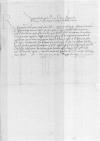Letter #5690
Sigismund I Jagiellon to Ioannes DANTISCUSLviv, 1537-09-06
| received [1537]-09-12 Manuscript sources:
| ||||
Text & apparatus & commentary Plain text Text & commentary Text & apparatus
Reverendo in Christo Patri
Reverende in Christo Pater, sincere nobis dilecte.
Quod iam certam spe[m] oblatam habeat Paternitas Vestra de assequendo isto Varmiensi episcopatu, est nobis gratum. Quam ut ex certa certiorem faciamus, hunc cubicularium rursus isthuc cum litteris, quas optabat Paternitas Vestra, mittimus et nuntium etiam, generosum
Gratum est nobis praeterea et acceptum, quod Paternitas Vestra instrumenta resignationis parrochialis in
Bene valeat Paternitas Vestra.
Datae in

